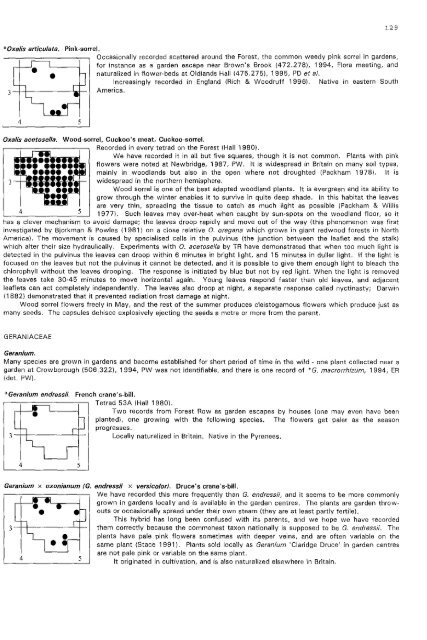Flora of Ashdown Forest - Botanical Society of the British Isles
Flora of Ashdown Forest - Botanical Society of the British Isles
Flora of Ashdown Forest - Botanical Society of the British Isles
Create successful ePaper yourself
Turn your PDF publications into a flip-book with our unique Google optimized e-Paper software.
129*Oxalis articulata. Pink-sorrel.•] -++-----'".t-Occasionally recorded scattered around <strong>the</strong> <strong>Forest</strong>, <strong>the</strong> common weedy pink sorrel in gardens,for instance as a garden escape near Brown's Brook (472.278), 1994, <strong>Flora</strong> meeting, andnaturalized in flower-beds at Oldlands Hall (475.275)' 1995, PD et al .Increasingly recorded in England (Rich & Woodruff 1996). Native in eastern SouthAmerica.4 5Oxalis acetosella. Wood-sorrel, Cuckoo's meat, Cuckoo-sorrel.Recorded in every tetrad on <strong>the</strong> <strong>Forest</strong> (Hall 1980).We have recorded it in all but 1ive squares, though it is not common. Plants with pinkflowers were noted at Newbridge, 1987, PW, It is widespread in Britain on many soil types,mainly in woodlands but also in <strong>the</strong> open where not droughted (Packham 1978). It iswidespread in <strong>the</strong> nor<strong>the</strong>rn hemisphere.Wood sorrel is one <strong>of</strong> <strong>the</strong> best adapted woodland plants. It is evergreen and its ability togrow through <strong>the</strong> winter enables it to survive in quite deep shade. In this habitat <strong>the</strong> leavesare very thin, spreading <strong>the</strong> tissue to catch as much light as possible (Packham & Willis1977), Such leaves may over~heat when caught by sun~spots on <strong>the</strong> woodland floor, so ithas a clever mechanism to avoid damage; <strong>the</strong> leaves droop rapidly and move out <strong>of</strong> <strong>the</strong> way (this phenomenon was firstinvestigated by Bjorkman & Powles (1981) on a close relative O. oregana which grows in giant redwood forests in NorthAmerica). The movement is caused by specialised cells in <strong>the</strong> pulvinus (<strong>the</strong> junction between <strong>the</strong> leaflet and <strong>the</strong> stalk)which alter <strong>the</strong>ir size hydraulically. Experiments with O. acetosella by TR have demonstrated that when too much light isdetected in <strong>the</strong> pulvinus <strong>the</strong> leaves can droop within 6 minutes in bright light, and 15 minutes in duller light. If <strong>the</strong> light isfocused on <strong>the</strong> leaves but not <strong>the</strong> pulvinus it cannot be detected, and it is possible to give <strong>the</strong>m enough light to bleach <strong>the</strong>chlorophyll without <strong>the</strong> leaves drooping. The response is initiated by blue but not by rep light. When <strong>the</strong> light is removed<strong>the</strong> leaves take 30~45 minutes to move horizontal again. Young leaves respond faster than old leaves, and adjacentleaflets can act completely independently. The leaves also droop at night, a separate response called nyctinasty; Darwin(1882) demonstrated that it prevented radiation frost damage at night.Wood sorrel flowers freely in May, and <strong>the</strong> rest <strong>of</strong> <strong>the</strong> summer produces cleistogamous flowers which produce just asmany seeds. The capsules dehisce explosively ejecting <strong>the</strong> seeds a metre or more from <strong>the</strong> parent.GERANIACEAEGeranium.Many species are grown in gardens and become established for short period <strong>of</strong> time in <strong>the</strong> wild ~ one plant collected near agarden at Crow borough (506.322), 1994, PW was not identifiable, and <strong>the</strong>re is one record <strong>of</strong> *G. macrorrhizum, 1994, ER(det. PW).*Geranium endressii. French crane's~bill.Tetrad 53A (Hall 1980).Two records from <strong>Forest</strong> Row as garden escapes by houses (one may even have beenplanted), one growing with <strong>the</strong> following species. The flowers get paler as <strong>the</strong> seasonprogresses.] --++-------'---1-- Locally naturalized in Britain. Native in <strong>the</strong> Pyrenees.4 5Geranium x oxonianum (G. endressii x versic%rj. Druce's crane's~bill.We have recorded this more fr~quently than G. endressii, and it seems to be more commonlygrown in gardens locally and is available in <strong>the</strong> garden centres. The plants are garden throwoutsor occasionally spread under <strong>the</strong>ir own steam (<strong>the</strong>y are at least partly fertile).] --++-----------'-+--This hybrid has long been confused with its parents, and we hope we have recorded<strong>the</strong>m correctly because <strong>the</strong> commonest taxon nationally is supposed to be G. endressii. The4 5plants have pale pink flowers sometimes with deeper veins, and are <strong>of</strong>ten variable on <strong>the</strong>same plant (Stace 1991). Plants sold locally as Geranium 'Claridge Druce' in garden centresare not pale pink or variable on <strong>the</strong> same plant.It originated in cultivation, and is also naturalized elsewhere in Britain.
















